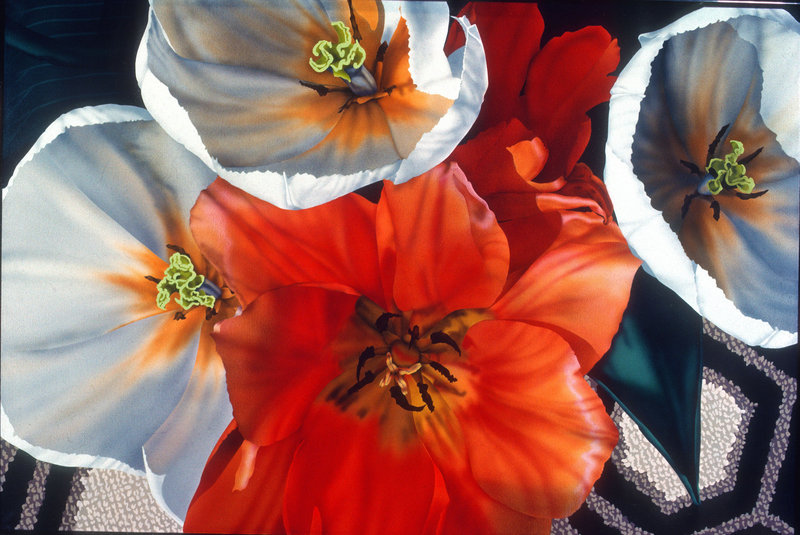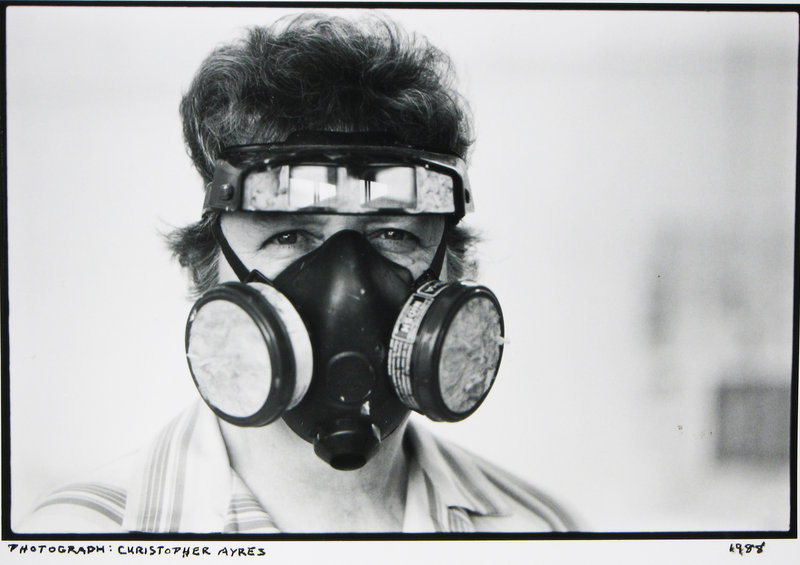OGUNQUIT – Beverly Hallam’s breathing is labored and her knees are wobbly, but the beloved York County artist is still endowed with verve for life.
She showed evidence of her enthusiasm when she showed up for the premiere of the latest film in the Maine Masters project, a documentary film series about important Maine artists. The Ogunquit Museum of American Art screened “Beverly Hallam: Artist as Innovator” on Tuesday night. MPBN broadcast it later in the week, and Blue Hill Public Library shows it at 5 p.m. Monday.
Hallam is a bit short on words these days. At age 88, her voice is weaker than we remember.
But she mustered the energy to greet well-wishers at a reception at the Oguquit museum before the movie, and gladly accepted a bouquet of flowers from museum director Ron Crusan when the lights came up afterward.
“Thank you very much,” she said as the audience rose to its feet in applause. “I appreciate every inch of that film.”
Directed by Maine filmmaker Richard Kane, the 30-minute movie documents Hallam’s remarkable and influential career. Based on interviews with Hallam; Vicki Wright, director of collections and exhibitions at the Kalamazoo Institute of Arts; gallerist John Whitney Payson; and art patron and Hallam confidante Mary-Leigh Smart, the movie makes a case for Hallam’s role as a pioneer.
She was among the very first to use acrylic paint successfully, and one of the first who mastered the air brush. She’s also an accomplished printmaker, and early in her career moved easily among styles.
Hallam’s deft handling of the air brush enabled her to make her large, colorful and complex paintings of flowers. Her flower paintings became her best-known body of work, and made her popular with museums and collectors alike.
EVOLVING, ADAPTING
More recently, as her painting skills have diminished with her declining health, Hallam mastered the use of computer graphics. She makes abstract compositions on her monitor, forming and manipulating shapes and infusing her work with splashes of color.
Color has been an important part of her life since childhood. In the movie, Hallam tells interviewer Carl Little that she fell in love with flowers as a youngster when, while walking to school in Lynn, Mass., she cut through a cemetery. All the flowers on the graves delighted her, and she has been enamored of them since.
But it wasn’t until she and Smart built a home at Surf Point in York in the mid-1970s that Hallam’s flower paintings fully blossomed. Throughout her career until then, Hallam’s painting studios were infused with north light, which is least favorable. At York, with a house facing the sea, the late-afternoon western sun draped the home in brilliant sunlight.
By manipulating vertical blinds, Hallam created a maze of interior shadows. She placed her flower arrangements on tables in such a way that the shadows from the blinds as well as reflections from mirrors resulted in a complex compositions. Inspired, she began making her large air-brush paintings.
As part of the new Maine Masters film, Kane incorporated footage from a previous film about Hallam that offered a detailed explanation of her airbrush process. Calvin Kimbrough Jr. made that film, “Beverly Hallam: The Flower Paintings,” in 1990 for the Evansville (Ind.) Museum of Art.
Little, a noted Maine art critic and writer, served as co-producer of the Maine Masters film. He interviewed Hallam for the movie, and also spent a great deal of time with her several years ago when he wrote the book “Beverly Hallam: An Odyssey in Art.”
Among the many things that impresses him about Hallam and her work is her willingness to reinvent herself and her lack of fear in exploring new ways of making art. Noting that Hallam comes from a family of inventors, Little cited her ingenuity as one of her most enduring and endearing traits.
“That’s why we called this movie ‘Artist as Innovator,’ ” he said. “Even now, she is exploring new work on her computer. That’s Bev in the 21st century. When her peers are fading into the sunset, she is doing this incredible work.”
AN OGUNQUIT INSTITUTION
Crusan said Hallam’s importance to the Ogunquit art scene cannot be overstated. Her presence in Ogunquit dates to the 1950s, when she began offering workshops in acrylics.
“She did workshops and classes, and introduced the whole concept of painting with something other than watercolors or oils. How amazing was that?” he said. “And then she got into airbrush, and people were asking, ‘What the heck is an airbrush?’
“Artist as innovator — that is her story. It fits her.”
As part of their legacy, Hallam and Smart have set up a foundation that will turn their York home into a retreat for artists, scholars, critics and historians after both women die.
The Surf Point Foundation will operate as an artist-in-residence operation, allowing artists and others whose expertise relates to the field of visual arts to come to York to work and study. Hallam and Smart built their home as a residence and studio, so it’s appropriate to ensure it continues in that manner after they die, Smart said.
Seated in a wheelchair, Hallam greeted visitor after visitor at the museum, shaking hands and engaging in quiet conversation. She rolled her eyes and laughed when asked if she liked all the attention.
She’d rather be back home working, she said — although she very much appreciates the attention and kindness.
“I still work sporadically, when the spirit moves me,” she said.
Her eyes sparkled at the thought.
Staff Writer Bob Keyes can be contacted at 791-6457 or at:
bkeyes@pressherald.com
Twitter: pphbkeyes
Copy the Story Link
Send questions/comments to the editors.





Success. Please wait for the page to reload. If the page does not reload within 5 seconds, please refresh the page.
Enter your email and password to access comments.
Hi, to comment on stories you must . This profile is in addition to your subscription and website login.
Already have a commenting profile? .
Invalid username/password.
Please check your email to confirm and complete your registration.
Only subscribers are eligible to post comments. Please subscribe or login first for digital access. Here’s why.
Use the form below to reset your password. When you've submitted your account email, we will send an email with a reset code.